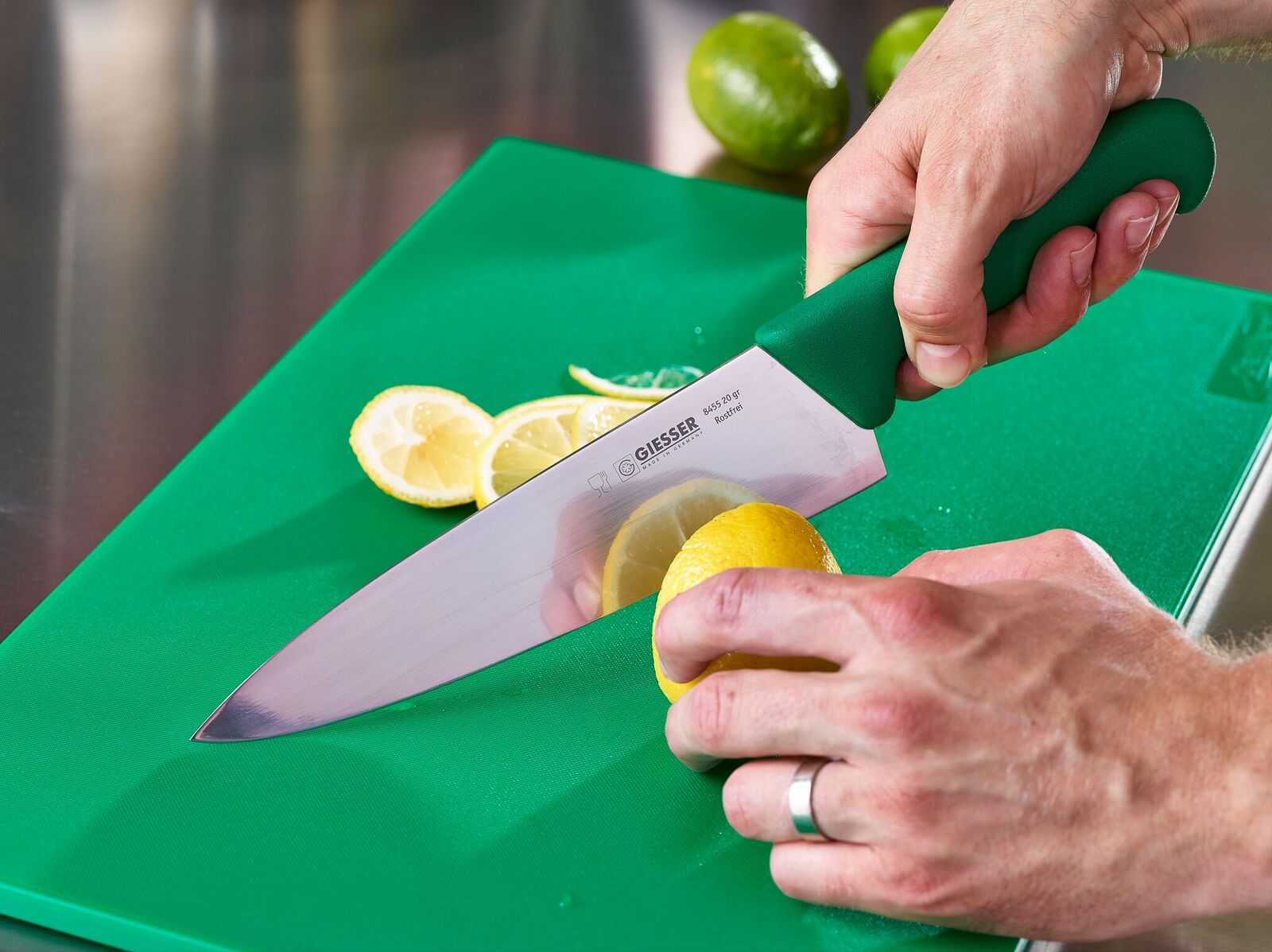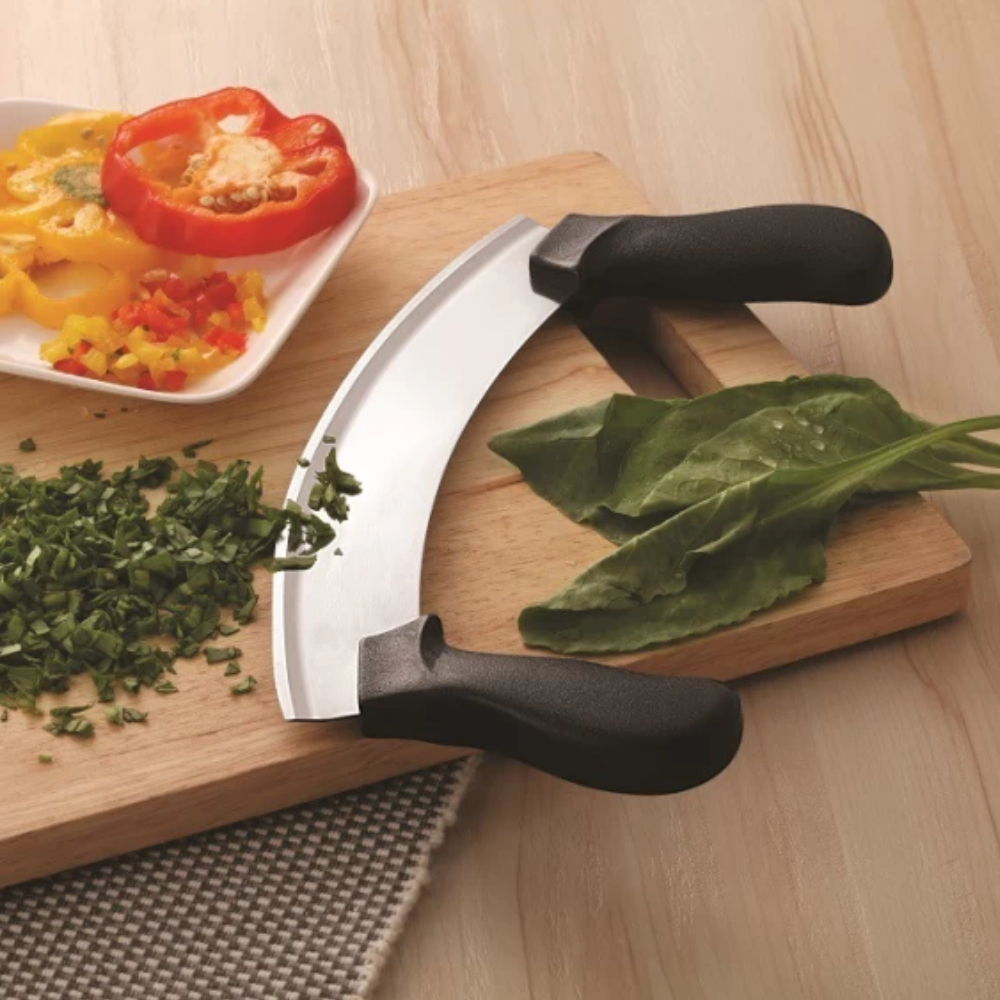Imagine two chefs, equally skilled. one with a trusty chef’s knife and paring knife, the other with a collection of knives for every task. Who’d likely create better dishes?
The specialist wins (usually).
The right blade for the job isn’t just about speed – it helps you achieve cleaner cuts that release more flavour from your ingredients. This guide explores different types of Western knives to upgrade your food prep skills.
Essential Knives:
Chef’s Knife: A chef’s knife excels at a wide range of tasks, from chopping vegetables to slicing meat. Its wider blade profile provides stability for forceful chopping, while the curved belly facilitates a rocking motion for quick mincing. However, its heavier weight may make it less suitable for delicate precision work.
Paring Knife: A paring knife tackles intricate kitchen tasks. It has a short and narrow blade, giving you superb manoeuvrability when peeling, coring, shaping, and trimming fruits and vegetables. It is ideal for intricate tasks like deveining shrimp, hulling strawberries, or removing seeds from peppers.
Some paring knives feature a unique curved beak shape blade, often nicknamed the “bird’s beak knife” due to its resemblance. This curved design has several advantages:
Closer Peeling: The curved form allows the blade to hug the contours of fruits and vegetables, minimizing waste during peeling.
Better Control: The beak shape offers more control for navigating tight spaces and around seeds or cores.
Delicate Cuts: The curved tip excels at making precise cuts for garnishes, decorative details, and intricate food presentations.
Vegetable Knife:
With Straight Blade: This compact knife features a straight blade designed for general vegetable prep work, such as slicing, dicing, and chopping. Ideal for chopping using a straight up-and-down motion (as opposed to a rocking motion used with a chef’s knife).
With Wavy Blade: Perfect for slicing through soft-skinned produce like tomatoes without crushing them. The wavy serrated blade glides through easily, slicing the skin while preserving the delicate flesh underneath.
Bread Knife: A bread knife has a serrated blade with a sawtooth edge, featuring sharp points that act like tiny individual blades. It is long so it can easily cover the width of most bread loaves. This design allows it to easily cut through tough bread crusts and tomatoes in sandwiches without crushing the delicate insides. The steel of the knife doesn’t need to be exceptionally hard because the sawing action relies on the pointed serrations for effective cutting.
Carving Knife: With its long, narrow blade and gentle curve, a carving knife is great for smooth, precise cuts. This geometry minimizes drag and tearing, preserving the integrity of meat and minimizing juice loss. Made of chrome molybdenum steel, it ensures a sharp edge for clean cuts, while balanced hardness prevents snapping during forceful strokes. Carving knives are particularly useful at rotisseries and charcuterie stations.


Specialised Knives:
Boning Knife: With a narrow, sharp blade and pointed tip, a boning knife is specifically designed for the task of removing bones from different types of meat.
Poultry Knife: A poultry knife is a specialized type of boning knife. If you primarily work with poultry, its compact size offers greater control in tight spaces around the small bones and joints of chicken, turkey, or duck. This minimizes tearing and allows you to recover more meat.
Filleting Knife: Delicate fish require a delicate touch. This is a type of boning knife specialized for fish. Its flexible blade allows for precise manoeuvring around bones and thin skin, minimizing waste. The narrow blade tapers towards the tip, enabling you to achieve incredibly thin slices.
Salmon Knife: A salmon knife is a specific type of filleting knife for filleting salmon and other large fish. Its longer and more flexible blade allows for precise and clean cuts along the fish’s contours, making it easier to remove the skin and bones while preserving the flesh. The blade’s flexibility enables it to manoeuvre around bones and follow the natural shape of the fish.
To prevent fish from sticking to the knife, opt for one with a scalloped blade. These tiny indentations along the blade create air pockets, which help reduce friction and prevent delicate fish flesh from clinging to the knife during slicing.
Butcher Knife: This knife boasts a long, strong blade for breaking large cuts of meat into manageable portions. Its extended length allows for smooth, precise slices, while the sturdy build powerfully cuts through and breaks apart tough meats. Butcher knives come in different sizes:
A smaller butcher knife works best for cutting up smaller meats like pork chops.
A larger butcher knife is better for slicing through bigger cuts of meat, like a whole ham or side of beef.
Ham Knife: This knife is great for cutting ham with minimal tearing of the meat. The long, thin blade of a ham knife has just the right amount of flexibility to handle tougher hams without being overly bendable. The blade’s length ensures it can cover the entire surface area of the cut in one smooth motion.
Universal Knife: This knife aims to be a “jack-of-all-trades” option.
A long universal knife features a medium-length blade with a serrated edge. This design allows it to handle some tasks of both a chef’s knife and a bread knife, but may not excel at either. It’s a good option for those with limited kitchen space or who prefer a single knife for basic chopping and slicing of various ingredients.
A short universal knife offers a more compact design with a serrated edge. It functions similarly to a small bread knife, ideal for tackling tasks like slicing tomatoes or crusty rolls.
Skinning Knife: This knife boasts a razor-sharp, stiff blade designed for removing animal hides. The stiffness allows for controlled cuts, ensuring clean separation of the skin from the underlying meat with minimal waste. Due to the blade’s sharpness and specialized use, proper technique and experience are crucial for safe and efficient operation. For this reason, skinning knives are generally not recommended for casual use in the home kitchen.
Bacon Knife: If you find yourself slicing bacon frequently, investing in a dedicated bacon knife could be worthwhile. It features a long and thin blade that allows for smooth, precise slicing through bacon strips without tearing or shredding. Its slightly flexible blade can contour to the shape of the bacon slices, facilitating smooth cutting motions and ensuring that each slice is uniform and appealing.
Mincing Knife: A mincing knife with two handles, also known as a mezzaluna or herb chopper, is perfect for finely mincing or chopping ingredients such as herbs, vegetables, nuts, or garlic. It consists of a curved blade with two handles positioned at each end, allowing the user to rock the blade back and forth to chop ingredients effortlessly.



There is no need to collect every knife out there. Instead, consider the ingredients you use most often and identify any gaps in your knife collection. By investing in knives specifically designed for those ingredients, you can significantly simplify your food prep.

